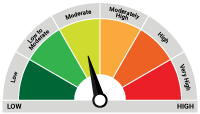Debt monthly view for November 2022
Posted On Monday, Dec 12, 2022
The bond market has a positive run in November with bond yields coming down by 10-25 basis points (bond prices increased) across different maturities of government bonds. The benchmark 10-year Indian government bond yield fell by 17 basis points to close at 7.28% on November 30, 2022.
The two main drivers of the bond rally in the last month were – (1) an over 10% decline in crude oil price amid slowing global growth and lockdown in China, and (2) a steep drop in US treasury yields in expectation of the US Federal Reserve slowing down the pace of rate hikes.
Domestically, the Reserve Bank of India also slowed down the pace of rate hikes by raising the repo rate by 35 basis points in the December MPC meeting from 5.9% to 6.25%. This was slower than three back-to-back 50 basis points increases and a 40 basis point increase in four preceding MPC meetings.
The RBI maintained its policy stance as “withdrawal of accommodation” with a focus on bringing down the core inflation (ex-food and fuel inflation) which has been steaky above the RBI’s 6% upper threshold. This indicates that the rate hiking cycle in India is not over.
We would expect at least another 25 basis points of a rate hike in February next year. The RBI might pause the hiking cycle thereafter subject to inflation trajectory and global monetary policy developments.
With RBI monetary policy out of way, the bond market will switch its focus to the US fed meeting due on December 14, 2022, and to fiscal calculations ahead of next year’s budget.
The US Fed is widely expected to hike interest rates by a reduced quantum of 50 basis points (vs 75 basis points increase in 3 three preceding meetings) in the upcoming FOMC meeting. However, given the recent robust data on the jobs market with the unemployment rate near a multiyear low at 3.7% and over 5% year-on-year increase in average hourly wages, we should expect the Fed to remain hawkish in its statement.
Going ahead, Indian bond yields will closely track these developments and the movement in US treasury yields and crude oil prices.
After a steep fall in yields over the last one month, there is a possibility of a rebound in yields from current levels. However, given the high level of absolute yields across the yield curve, we expect the upside to remain capped. We expect the 10-year government bond yield to continue to trade between 7.2% to 7.5%.
Given much of the rate hikes have already been delivered and the starting yields on short to medium-duration bonds are between 7.0%-7.5%, bond funds are likely to do better over the coming 2-3 years. Investors with a 2-3 years investment horizon and some appetite for intermittent volatility, can continue to add to dynamic bond funds in a staggered manner.
Dynamic bond funds have the flexibility to change the portfolio positioning as per the evolving market conditions. This makes dynamic bond funds better suited for long-term investors in this volatile macro environment.
Investors with shorter investment horizons and low-risk appetite should stick with liquid funds. Rate hikes and continued reduction in durable liquidity surplus are positive for short-term debt fund categories like the liquid fund. We would expect further improvement in the return potential of these categories as interest accrual on short-term debt instruments has risen meaningfully.
Since the interest rate on bank saving accounts are not likely to increase quickly while the returns from the liquid fund are already seeing an increase, investing in liquid funds looks more attractive for your surplus funds.
Investors with a short-term investment horizon and with little desire to take risks should invest in liquid funds which own government securities and do not invest in private sector companies which carry lower liquidity and higher risk of capital loss in case of default.
Source: RBI
| Name of the Scheme | This product is suitable for investors who are seeking* | Riskometer |
| Quantum Dynamic Bond Fund An Open-ended Dynamic Debt Scheme Investing Across Duration. A relatively high interest rate risk and relatively low credit risk. | • Regular income over short to medium term and capital appreciation • Investment in Debt / Money Market Instruments / Government Securities |  Investors understand that their principal will be at Moderate Risk |
*Investors should consult their financial advisers if in doubt about whether the product is suitable for them.
| Potential Risk Class Matrix – Quantum Dynamic Bond Fund | |||
| Credit Risk → | Relatively Low | Moderate (Class B) | Relatively High (Class C) |
| Interest Rate Risk↓ | |||
| Relatively Low (Class I) | |||
| Moderate (Class II) | |||
| Relatively High (Class III) | A-III | ||
Disclaimer, Statutory Details & Risk Factors:The views expressed here in this article / video are for general information and reading purpose only and do not constitute any guidelines and recommendations on any course of action to be followed by the reader. Quantum AMC / Quantum Mutual Fund is not guaranteeing / offering / communicating any indicative yield on investments made in the scheme(s). The views are not meant to serve as a professional guide / investment advice / intended to be an offer or solicitation for the purchase or sale of any financial product or instrument or mutual fund units for the reader. The article has been prepared on the basis of publicly available information, internally developed data and other sources believed to be reliable. Whilst no action has been solicited based upon the information provided herein, due care has been taken to ensure that the facts are accurate and views given are fair and reasonable as on date. Readers of this article should rely on information/data arising out of their own investigations and advised to seek independent professional advice and arrive at an informed decision before making any investments. Mutual fund investments are subject to market risks read all scheme related documents carefully.Please visit – www.QuantumAMC.com to read scheme specific risk factors. Investors in the Scheme(s) are not being offered a guaranteed or assured rate of return and there can be no assurance that the schemes objective will be achieved and the NAV of the scheme(s) may go up and down depending upon the factors and forces affecting securities market. Investment in mutual fund units involves investment risk such as trading volumes, settlement risk, liquidity risk, default risk including possible loss of capital. Past performance of the sponsor / AMC / Mutual Fund does not indicate the future performance of the Scheme(s). Statutory Details: Quantum Mutual Fund (the Fund) has been constituted as a Trust under the Indian Trusts Act, 1882. Sponsor: Quantum Advisors Private Limited. (liability of Sponsor limited to Rs. 1,00,000/-) Trustee: Quantum Trustee Company Private Limited. Investment Manager: Quantum Asset Management Company Private Limited. The Sponsor, Trustee and Investment Manager are incorporated under the Companies Act, 1956. |
Related Posts
-

Debt Monthly for December 2025
Posted On Tuesday, Dec 02, 2025
As we approach the end of the calendar year, we find ourselves at a pivotal moment, with the market split on the likelihood of an upcoming rate cut.
Read More -

Debt Monthly for November 2025
Posted On Tuesday, Nov 04, 2025
October 2025 in a Nutshell: Monetary Policy and Demand–Supply
Read More -

Debt Monthly for October 2025
Posted On Friday, Oct 03, 2025
September was a pivotal month for fixed income markets, both globally and domestically.
Read More



